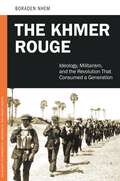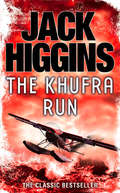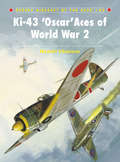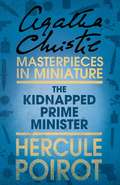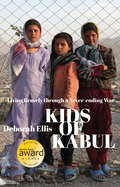- Table View
- List View
KGB Lexicon: The Soviet Intelligence Officers Handbook
by Vasili MitrokhinIn this volume Mitrokhin presents two dictionaries produced by the KGB itself to define their activities in both offensive and defensive intelligence work. The translated documents tell the story of the KGB's methods and targets and should interest the general public as well as the specialist.
Kharkov 1942: The Wehrmacht strikes back (Campaign)
by Howard Gerrard Robert ForczykAfter failing to finish off the German Army in the 1941/42 Winter Counteroffensive Stalin directed the Red Army to conduct a powerful blow in one sector of the Eastern Front in order to disrupt German plans. The sector chosen was Kharkov. Under Marshal Semyon Timoshenko, the Stavka's remaining reserves were assembled and prepared to conduct a breakthrough attack intended to encircle the German Sixth Army near Kharkov. However, Stalin was unaware that the Germans were planning their own riposte at Kharkov, known as Operation Fredericus. When Timoshenko began his offensive in May 1942, he did not realize the limitations of his own forces or the agility of the Germans to recover from setbacks, all of which contributed to one of the Red Army greatest defeats of World War II. This volume will pay particular attention to intelligence and logistics issues, as well as how this campaign served as a prelude to the battle of Stalingrad. It will also focus on the nascent development of the Red Army's tank corps and 'deep battle' tactics, as well as the revival of the German Panzertruppen after Barbarossa.
Kharkov 1942: The Wehrmacht strikes back (Campaign #254)
by Howard Gerrard Robert ForczykAfter failing to finish off the German Army in the 1941/42 Winter Counteroffensive Stalin directed the Red Army to conduct a powerful blow in one sector of the Eastern Front in order to disrupt German plans. The sector chosen was Kharkov. Under Marshal Semyon Timoshenko, the Stavka's remaining reserves were assembled and prepared to conduct a breakthrough attack intended to encircle the German Sixth Army near Kharkov. However, Stalin was unaware that the Germans were planning their own riposte at Kharkov, known as Operation Fredericus. When Timoshenko began his offensive in May 1942, he did not realize the limitations of his own forces or the agility of the Germans to recover from setbacks, all of which contributed to one of the Red Army greatest defeats of World War II. This volume will pay particular attention to intelligence and logistics issues, as well as how this campaign served as a prelude to the battle of Stalingrad. It will also focus on the nascent development of the Red Army's tank corps and 'deep battle' tactics, as well as the revival of the German Panzertruppen after Barbarossa.
Khartoum 1885: General Gordon's last stand (Campaign #23)
by Donald FeatherstoneEarly in 1881 unrest in the Sudan began to crystallise around Mohammed Ibn Ahmed el-Sayyid Abdullah. Proclaiming himself the long-expected Madhi, the Guided One of the Prophet, he preached that the Sudan was to be purged of its Egyptian oppressors. Drawn in by the Egyptian failure to deal with the situation, the British sent General Gordon to organise an evacuation. On reaching Khartoum however, General Gordon believed, incorrectly, that the Madhi could be reasoned with. Instead of negotiating, the Madhi besieged the town for 317 days. This title looks in particular, although not exclusively, at the battles fought by the British columns sent to relieve Khartoum.
Khartoum 1885: General Gordon's last stand (Campaign #23)
by Donald FeatherstoneEarly in 1881 unrest in the Sudan began to crystallise around Mohammed Ibn Ahmed el-Sayyid Abdullah. Proclaiming himself the long-expected Madhi, the Guided One of the Prophet, he preached that the Sudan was to be purged of its Egyptian oppressors. Drawn in by the Egyptian failure to deal with the situation, the British sent General Gordon to organise an evacuation. On reaching Khartoum however, General Gordon believed, incorrectly, that the Madhi could be reasoned with. Instead of negotiating, the Madhi besieged the town for 317 days. This title looks in particular, although not exclusively, at the battles fought by the British columns sent to relieve Khartoum.
The Khazars: A Judeo-Turkish Empire on the Steppes, 7th–11th Centuries AD (Men-at-Arms)
by David Nicolle Mikhail ZhirohovThe Khazars were one of the most important Turkic peoples in European history, dominating vast areas of southeastern Europe and the western reaches of the Central Asian steppes from the 4th to the 11th centuries AD. They were also unique in that their aristocratic and military elites converted to Judaism, creating what would be territorially the largest Jewish-ruled state in world history. They became significant allies of the Byzantine Empire, blocking the advance of Islam north of the Caucasus Mountains for several hundred years. They also achieved a remarkable level of metal-working technology, and their military elite wore forms of iron plate armour that would not be seen in Western Europe until the 14th century. The Khazar state provided the foundations upon which medieval Russia and modern Ukraine were built. Fully illustrated with detailed colour plates, this is a fascinating study into the armies, organisation, armour, weapons and fortifications of the Khazars.
The Khazars: A Judeo-Turkish Empire on the Steppes, 7th–11th Centuries AD (Men-at-Arms #522)
by David Nicolle Mikhail ZhirohovThe Khazars were one of the most important Turkic peoples in European history, dominating vast areas of southeastern Europe and the western reaches of the Central Asian steppes from the 4th to the 11th centuries AD. They were also unique in that their aristocratic and military elites converted to Judaism, creating what would be territorially the largest Jewish-ruled state in world history. They became significant allies of the Byzantine Empire, blocking the advance of Islam north of the Caucasus Mountains for several hundred years. They also achieved a remarkable level of metal-working technology, and their military elite wore forms of iron plate armour that would not be seen in Western Europe until the 14th century. The Khazar state provided the foundations upon which medieval Russia and modern Ukraine were built. Fully illustrated with detailed colour plates, this is a fascinating study into the armies, organisation, armour, weapons and fortifications of the Khazars.
Khe Sanh 1967–68: Marines battle for Vietnam’s vital hilltop base (Campaign)
by Peter Dennis Gordon L. RottmanKhe Sanh was a small village in northwest South Vietnam that sat astride key North Vietnamese infiltration routes. In September 1966 a Marine battalion deployed into the area. Action gradually increased as the NVA attempted to destroy Free World Forces bases, and the siege of Khe Sanh proper began in October 1967. The bitter fight lasted into July 1968 when, with the changing strategic and tactical situation, the base was finally closed. This book details the siege and explains how, although the NVA successfully overran a Special Forces camp nearby, it was unable to drive US forces from Khe Sanh.
Khe Sanh 1967–68: Marines battle for Vietnam’s vital hilltop base (Campaign)
by Gordon L. RottmanKhe Sanh was a small village in northwest South Vietnam that sat astride key North Vietnamese infiltration routes. In September 1966 a Marine battalion deployed into the area. Action gradually increased as the NVA attempted to destroy Free World Forces bases, and the siege of Khe Sanh proper began in October 1967. The bitter fight lasted into July 1968 when, with the changing strategic and tactical situation, the base was finally closed. This book details the siege and explains how, although the NVA successfully overran a Special Forces camp nearby, it was unable to drive US forces from Khe Sanh.
Khmer Nationalist: Sơn Ngọc Thành, the CIA, and the Transformation of Cambodia (NIU Southeast Asian Series)
by Matthew JagelKhmer Nationalist is a political history of Cambodia from World War II until 1975, examining the central role of Sõn Ngọc Thành. It is a story of nationalistic independence movements, political intrigue, coup attempts, war, and American intelligence. The rise of Cambodian nationalism, the brief period of Japanese dominance, the fight for independence from France, and the establishment of ties with the United States that kept Sihanouk on edge until his downfall—in all of these, as Matthew Jagel shows, Thành was fundamental.Khmer Nationalist reveals how Cambodian nationalism grew during the twilight of French colonialism and faced new geopolitical challenges during the Cold War. Thành's story brings greater understanding to the end of French colonialism in Cambodia, nationalism in post-colonial societies, Cold War realities for countries caught between competing powers, and how the United States responded while the Vietnam War intensified.
The Khmer Rouge: Ideology, Militarism, and the Revolution That Consumed a Generation (PSI Guides to Terrorists, Insurgents, and Armed Groups)
by Nhem BoradenThis book provides a comprehensive yet concise narrative of the history of the Khmer Rouge, from its inception during the 1950s through its eventual reintegration into Cambodian society in 1998.The Khmer Rouge: Ideology, Militarism, and the Revolution That Consumed a Generation examines the entire organizational life of the Khmer Rouge, looking at it from both a societal and organizational perspective. The chapters cover each pivotal period in the history of the Khmer Rouge, explaining how extreme militarism, organizational dynamics, leadership policies, and international context all conspired to establish, maintain, and destroy the Khmer Rouge as an organization. The work goes beyond inspecting the actions of a few key leadership individuals to describe the interaction among different groups of elites as well as the ideologies and culture that formed the structural foundation of the organization.
The Khmer Rouge: Ideology, Militarism, and the Revolution That Consumed a Generation (PSI Guides to Terrorists, Insurgents, and Armed Groups)
by Nhem BoradenThis book provides a comprehensive yet concise narrative of the history of the Khmer Rouge, from its inception during the 1950s through its eventual reintegration into Cambodian society in 1998.The Khmer Rouge: Ideology, Militarism, and the Revolution That Consumed a Generation examines the entire organizational life of the Khmer Rouge, looking at it from both a societal and organizational perspective. The chapters cover each pivotal period in the history of the Khmer Rouge, explaining how extreme militarism, organizational dynamics, leadership policies, and international context all conspired to establish, maintain, and destroy the Khmer Rouge as an organization. The work goes beyond inspecting the actions of a few key leadership individuals to describe the interaction among different groups of elites as well as the ideologies and culture that formed the structural foundation of the organization.
Khomeini's Ghost: Iran since 1979
by Con CoughlinOn 1 February 1979 Ayatollah Khomeini returned to Iran to a tumultuous welcome and the Iranian revolution that that he masterminded has become one of the defining moments of the modern age. Today the challenge of radical Islam represents the greatest threat to world peace seen since the darkest days of the Cold War, and the legacy of Khomeini’s Islamic Revolution lies at the heart of many of the world’s most intractable conflicts. Khomeini’s Ghost is the definitive biographical account of how an impoverished young student from a remote area of southern Iran came to be the political and the spiritual leader of his country. Drawing on a wide variety of Iranian sources, including religious figures who knew and worked with Khomeini both in exile and in power, Con Coughlin examines in detail the principles of Khomeini’s Islamic Revolution and the impact of his legacy today, whether it is in Iran’s support for radical Islamic groups or Iran’s commitment to developing an atom bomb. Frighteningly topical, compellingly readable and written with authority and profound understanding of the subject, this is political biography at its best.
The Khufra Run (Playaway Adult Fiction Ser.)
by Jack HigginsClassic Jack Higgins for the new generation
Ki-43 ‘Oscar’ Aces of World War 2 (Aircraft of the Aces)
by Jim Laurier Hiroshi IchimuraDubbed the 'Oscar' by the Allies, the Ki-43 Hayabusa Peregrine was the most prolific Japanese fighter of World War 2. Designed for manoeuverability and speed, the low-wing model meant that firepower and safety had to be sacrificed, with only two machine guns per plane. Despite this, more Japanese pilots achieved Ace status flying the Hayabusa than any other plane. This book expertly charts the experiences of the pilots and discusses the early stages of the war in South-East Asia, China, Burma and New Guinea. Accompanied by detailed appendices and specially commissioned artwork, this is the first volume in English to focus exclusively on the exploits of the Ki-43.
Ki-43 ‘Oscar’ Aces of World War 2 (Aircraft of the Aces)
by Jim Laurier Hiroshi IchimuraDubbed the 'Oscar' by the Allies, the Ki-43 Hayabusa Peregrine was the most prolific Japanese fighter of World War 2. Designed for manoeuverability and speed, the low-wing model meant that firepower and safety had to be sacrificed, with only two machine guns per plane. Despite this, more Japanese pilots achieved Ace status flying the Hayabusa than any other plane. This book expertly charts the experiences of the pilots and discusses the early stages of the war in South-East Asia, China, Burma and New Guinea. Accompanied by detailed appendices and specially commissioned artwork, this is the first volume in English to focus exclusively on the exploits of the Ki-43.
Ki-61 and Ki-100 Aces (Aircraft of the Aces)
by Nicholas Millman Ronnie OlsthoornThis is the story of the elite Japanese Army Air force (JAAF) aces that flew the Kawasaki Ki-61 Hien (Swallow), and the Ki-100 Goshikisen in the Pacific Theatre of World War 2. The former, codenamed 'Tony' by the allies, was a technically excellent aircraft, possessing power, stability and a good rate of climb - differing radically from the usual Japanese philosophy of building light, ultra-manoeuvrable fighters. Its pilots soon realised, however, that the type was plagued by a number of dangerous mechanical issues. Then as the war moved relentlessly closer to Japan's doorstep, a desperate, expedient innovation to the Ki-61 airframe by fitting it with a radial instead of inline engine resulted in one of the finest fighters of World War 2 - the Ki-100. This book uses the latest findings to provide a gripping account of some of the most remarkable and hard-pressed fighter pilots of the war. It reveals how these men, unlike so many of their unfortunate late-war colleagues, could surprise Allied aircraft in high-performance fighters and claim successes in the face of enormous odds.
Ki-61 and Ki-100 Aces (Aircraft of the Aces #114)
by Nicholas Millman Ronnie OlsthoornThis is the story of the elite Japanese Army Air force (JAAF) aces that flew the Kawasaki Ki-61 Hien (Swallow), and the Ki-100 Goshikisen in the Pacific Theatre of World War 2. The former, codenamed 'Tony' by the allies, was a technically excellent aircraft, possessing power, stability and a good rate of climb - differing radically from the usual Japanese philosophy of building light, ultra-manoeuvrable fighters. Its pilots soon realised, however, that the type was plagued by a number of dangerous mechanical issues. Then as the war moved relentlessly closer to Japan's doorstep, a desperate, expedient innovation to the Ki-61 airframe by fitting it with a radial instead of inline engine resulted in one of the finest fighters of World War 2 - the Ki-100. This book uses the latest findings to provide a gripping account of some of the most remarkable and hard-pressed fighter pilots of the war. It reveals how these men, unlike so many of their unfortunate late-war colleagues, could surprise Allied aircraft in high-performance fighters and claim successes in the face of enormous odds.
A Kick Against The Pricks: The Autobiography
by David NorrisDavid Norris is one of Ireland’s most popular, colourful and charismatic public figures. Not a man to shy away from controversy, he has spent most of his adult life challenging the establishment, whether as a leading campaigner for gay rights, a passionate conservationist, an unconventional academic and Joycean scholar, a brilliant raconteur, or, since 1987, a fiercely independent Senator and outspoken defender of human rights.Born in the Belgian Congo to an English father, who died when he was six years old, and an Irish mother, who died when he was twenty-one, David has been a Dubliner all his life, and the city of Ulysses remains one of his great passions. He spear-headed the revival of Georgian Dublin, particularly through his campaign to save North Great George’s Street, where he has lived for the last thirty-five years.But it is David Norris’s campaign to decriminalize homosexuality that will stand as his major legacy. Over a long sixteen years, he fought a difficult battle to overturn the Victorian law, finally winning a historic victory in the European Court of Human Rights in 1988.David’s decision to run for President of Ireland in 2011 was not lightly taken, but it proved to be the most bruising period of his life. His popularity and the public affection in which he is held saw him quickly established as the front-runner. However, a sustained and hostile media campaign forced him out of the race; although he re-entered it in the autumn, the momentum had been lost. In these pages, David Norris reveals for the first time the full, no-holds-barred story of his presidential campaign, and of how he recovered from the turmoil.A Kick Against the Pricks is a brilliant, deeply revealing autobiography, a remarkable journey from the margins to the centre of Irish society.
Kidnap and Ransom (A Kelly Jones Novel #4)
by Michelle GagnonWhen the world's foremost kidnap and ransom negotiator is snatched by a ruthless drug cartel, Jake Riley becomes ensnared in the effort to save him.
Kidnap in Crete: The True Story of the Abduction of a Nazi General
by Rick StroudThis is the story of how a small SOE unit led by Patrick Leigh Fermor kidnapped a German general on the Nazi-occupied island of Crete in 1944. For thirty-two days, they were chased across the mountains as they headed for the coast and a rendezvous with a Royal Navy launch waiting to spirit the general to Cairo. Rick Stroud, whose Phantom Army of Alamein won plaudits for its meticulous research and its lightness of touch in the telling, brings these same gifts to bear in this new project. From the adrenalin rush of the kidnapping, to the help provided by the Cretan partisans and people, he explains the overall context of Crete's role in World War Two and reveals the devastating consequences of this mission for them all.There have been other accounts - notably Ill Met By Moonlight by William Stanley Moss (Leigh Fermor's second in command), which was later made into a Powell and Pressburger film, starring Dirk Bogarde - but Kidnap in Crete is the first book to draw on all the sources, notably those in Crete as well as SOE files and the accounts, letters and private papers of its operatives in London and Edinburgh.
Kidnap in Crete: The True Story of the Abduction of a Nazi General
by Rick StroudThis is the story of how a small SOE unit led by Patrick Leigh Fermor kidnapped a German general on the Nazi-occupied island of Crete in 1944. For thirty-two days, they were chased across the mountains as they headed for the coast and a rendezvous with a Royal Navy launch waiting to spirit the general to Cairo. Rick Stroud, whose Phantom Army of Alamein won plaudits for its meticulous research and its lightness of touch in the telling, brings these same gifts to bear in this new project. From the adrenalin rush of the kidnapping, to the help provided by the Cretan partisans and people, he explains the overall context of Crete's role in World War II and reveals the devastating consequences of this mission for them all. There have been other accounts, but Kidnap in Crete is the first book to draw on all the sources, notably those in Crete as well as SOE files and the accounts, letters, and private papers of its operatives in London and Edinburgh.
Kidnap the Emperor! (SAS Operation)
by Jay GarnetUltimate soldier. Ultimate mission. But can the SAS pull off a daring prison break and escape from Communist-run Ethiopia alive?
The Kidnapped Prime Minister: An Agatha Christie Short Story
by Agatha ChristieA classic Agatha Christie short story, available individually for the first time as an ebook.
Kids of Kabul: Living Bravely through a Never-ending War
by Deborah EllisSince its publication in 2000, hundreds of thousands of children all over the world have read and loved The Breadwinner, the fictional story of eleven-year-old Parvana living in Kabul under the terror of the Taliban. But what happened to Afghanistan’s children after the fall of the Taliban in 2001? In 2011, Deborah Ellis went to Kabul to find out. The twenty-six boys and girls featured in this book range in age from ten to seventeen, and they speak candidly about their lives now. They are still living in a country at war. Violence and oppression exist all around them. The situation for girls has improved, but it is still difficult and dangerous. And many children — boys and girls — are still supporting their families by selling items like pencils and matches on the street. Yet these kids are weathering their lives with remarkable courage and hope, getting as much education and life experience and fun as they can. All royalties from the sale of Kids of Kabul will go to Canadian Women for Women in Afghanistan (www.cw4wafghan.ca), which administers Parvana’s Fund, supporting schools, libraries and literacy programs for Afghan women and children. Key Text Features photographs maps glossary introduction historical context additional information Correlates to the Common Core State Standards in English Language Arts: CCSS.ELA-LITERACY.RI.5.6 Analyze multiple accounts of the same event or topic, noting important similarities and differences in the point of view they represent. CCSS.ELA-LITERACY.RI.6.6 Determine an author's point of view or purpose in a text and explain how it is conveyed in the text. CCSS.ELA-LITERACY.RI.6.9 Compare and contrast one author's presentation of events with that of another (e.g., a memoir written by and a biography on the same person).







